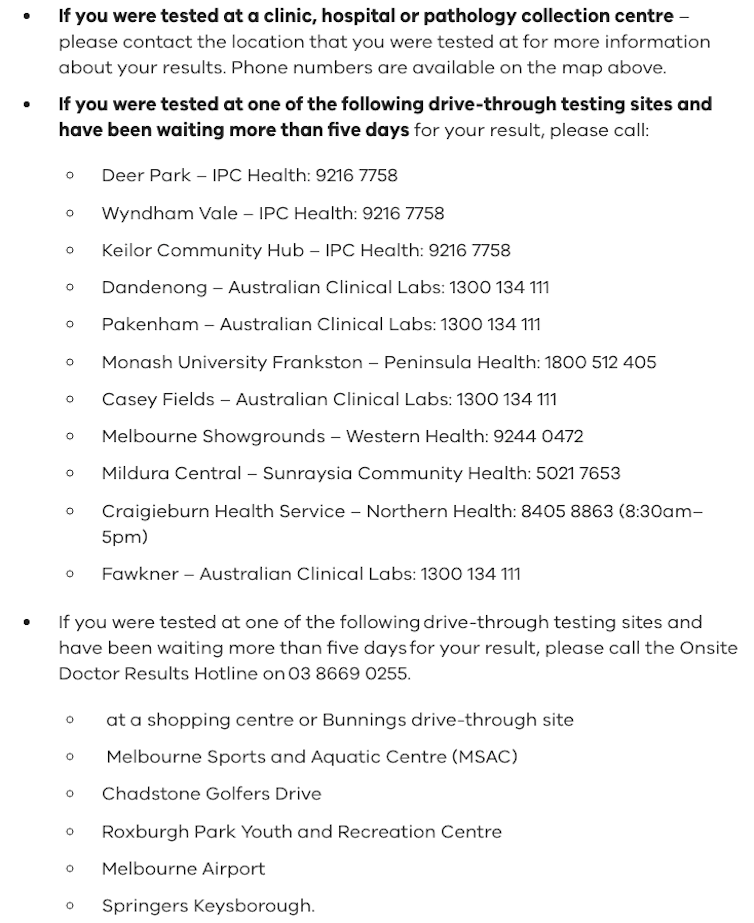Got a COVID-19 test in Victoria and still haven't got your results? Here's what may be happening — and what to do
- Written by Hassan Vally, Associate Professor, La Trobe University
Stories are emerging of Victorians who have followed advice and sought a COVID-19 test, only to find they’re still waiting to hear results more than five days later.
The scale of testing underway in Victoria — and Australia’s testing rates are among the highest in the world — means it’s likely this will happen from time to time. It’s unclear if this is happening to many people or to just a handful.
Nevertheless, it’s evidently happening to some people and we can piece together some information about what may be contributing to this problem, and what you can do if it happens to you.
What to do if it happens to you in Victoria
Firstly, if you are showing symptoms and still waiting on results of a test, it’s important you do not go out. Of course, that will grow increasingly difficult the longer you wait for a test result but self-isolating while awaiting test results is a crucial part of the pandemic management strategy.
Victorian health minister Jenny Mikakos said on Twitter results are usually available within 1-3 days or “sometimes longer” and referred people to a health department fact sheet.
The factsheet says:
Victorian and interstate labs are working around the clock to process all the tests, but with so many coming in every day, sometimes it takes a little longer to confirm the results.
It lists phone numbers to try if you haven’t got your result within the expected time frame.
 Information from a Victorian health department factsheet.
DHHS
Information from a Victorian health department factsheet.
DHHS
The factsheet doesn’t say what to do if you did the test using a home testing kit but the Victorian Department of Health and Human Services later tweeted to say:
Of course, if all else fails it might be simplest just to go and get another test.
Why might this be happening?
Again, we must acknowledge the enormous scale of the testing program underway in Victoria.
On Wednesday alone, 28,607 tests were undertaken in Victoria, and the total number of tests undertaken since January 1 is now at 1,225,999, Victorian Premier Daniel Andrews said in his Thursday press briefing.
Widespread testing is one of the best things we can do to control the spread of coronavirus, and these numbers are very impressive.
Many of these tests will be processed at laboratories in other states, as it is not possible for Victorian labs to test so many samples on their own.
A health department factsheet dated June 25, 2020 said:
Laboratories in Victoria, with surge staff capacity, can process 18,000 tests a day, noting that turn-around times are adversely affected when there is sustained testing above 14,000 tests per day.
New South Wales, South Australia, Queensland and Tasmania have agreed to provide surge lab capacity of over 4,000 tests a day. Private laboratories can also provide surge capacity of around 13,500 tests a day through their interstate operations. This will allow for at least 25,000 Victorian tests to be processed a day. There are currently sufficient test kits to meet this level of demand.
In addition, private pathology providers can draw on interstate supply chains. Safeguards, including repeat testing, will manage the risk of false positive tests.
So if you’ve got a test but haven’t heard back, it’s possible the delay is caused by test samples needing to be taken to interstate labs (which adds time) and the huge scale of testing underway.
It’s also possible there may have been some other problem with the test, so make sure you double check at the testing centre.
Who should get tested and why testing is important?
The Victorian health department says on its website:
Testing is currently available for people with the following symptoms, however mild: fever, chills or sweats, cough, sore throat, shortness of breath, runny nose, and loss of sense of smell or taste. The test takes around a minute and involves a swab from the back of your throat and nose.
The less invasive saliva test may also be available for some people in certain places and circumstances, the department has said.
Despite any difficulties you may be experiencing in getting tested or in getting your results, it’s vital to understand how critical getting tested is to protecting the community from this coronavirus. By being tested you are helping limit the spread of COVID-19. You are potentially helping save lives.
Authors: Hassan Vally, Associate Professor, La Trobe University





